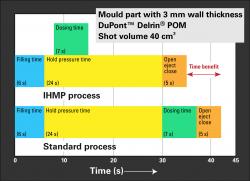plasticker-News
| 2011-11-10, 10:30 |

|
DuPont: IMHP technology to decrease cycle time during the injection moulding of semi-crystalline thermoplastics
 Photo: DuPont. In IMHP technology (In-Mould Hold Pressure) from DuPont, hold pressure is applied using a separate mechanism integrated within the mould during the screw-dosing phase. This parallel arrangement of two injection moulding phases helps can help reduce cycle time. The actual time saving is largely determined by the degree of crystallinity of the processed material and the shot volume. The IMHP process from DuPont offers two different methods - each integrated within the mould - for applying hold pressure and the successive feeding of molten material. As part of the first method, a hydraulically-operated piston, which is integrated in the movable side of the mould, is immersed in a specially provisioned and appropriately-dosed melt cushion. Alternatively, the equivalent melt volume is available on the stationary side of the mould in the hot runner. In this case, the molten material is pressed into the cavity using a needle-valve-like mechanism. Both methods are currently being trialled and refined by DuPont, with a current emphasis on minimising the additional space required. "We have conducted numerous injection moulding trials with different semi-crystalline thermoplastics grades at our Technical Center in Meyrin, Switzerland, and were able to demonstrate, on the basis of producing standard bars used for tensile testing, the potential efficiency improvements," comments Ernst A. Poppe, European manager for application and processing technology at DuPont Performance Polymers. "IMHP technology proved itself to be particularly beneficial when moulding DuPont™ Delrin® acetal resin, for which - as is the case with all grades of this particular family of thermoplastics - the hold pressure time constitutes a large proportion of its overall cycle time. Additionally we were able to demonstrate that there were no significant changes in terms of dimensional stability and mechanical properties between standard injection-moulded samples and such produced with IMHP technology. The next step will be for us to work with moulders, hot runner and machinery producers in refining the engineering aspects of the process and thereby ensuring market entry for this time- and cost-saving technology for the moulding of semi-crystalline thermoplastics." More information: www.dupont.com |
DuPont de Nemours International Sarl., Genf, Schweiz
 back to news list back to news list |  back to top back to top |









